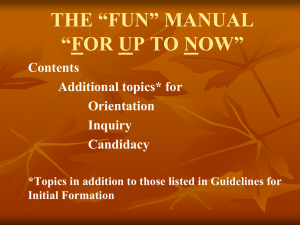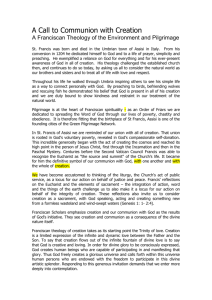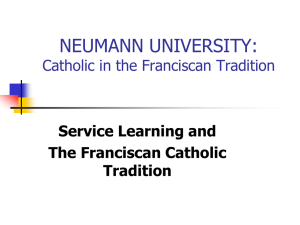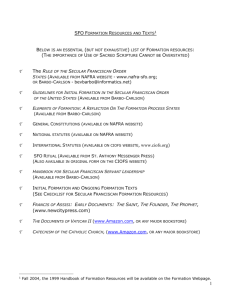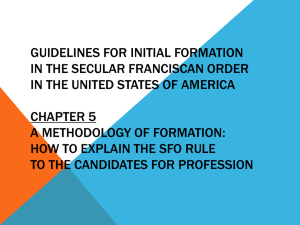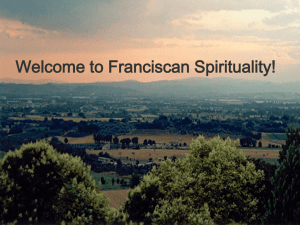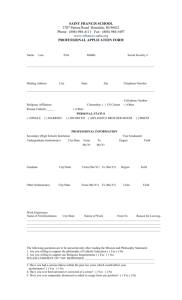THE CLASSICS OF WESTERN SPIRITUALITY
advertisement
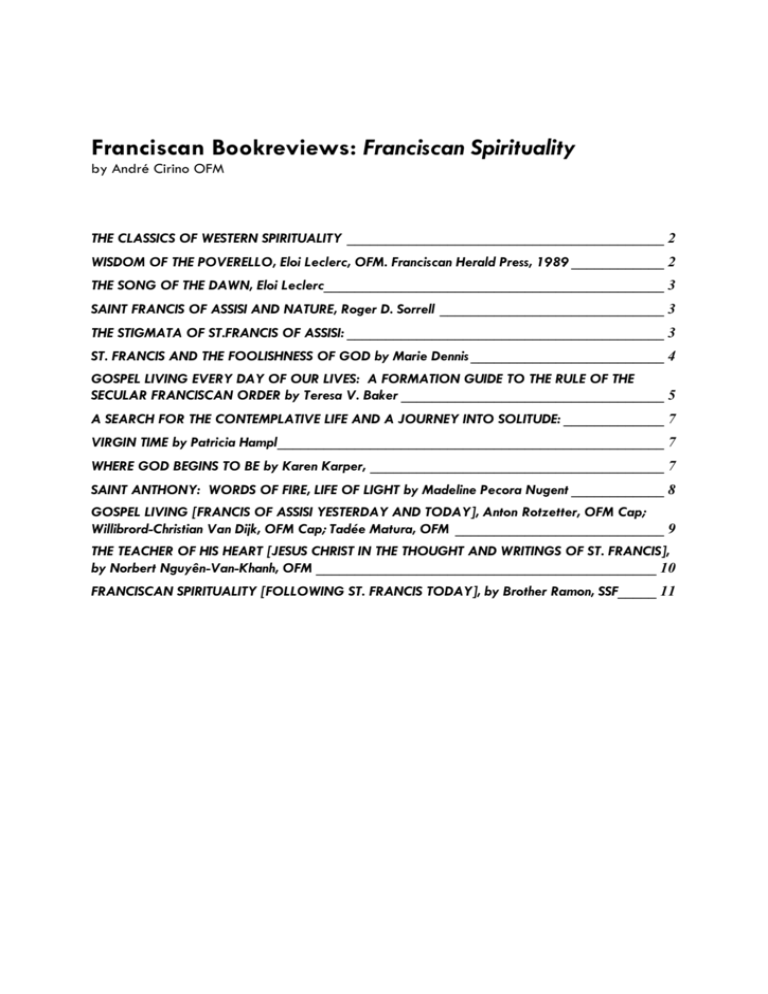
Franciscan Bookreviews: Franciscan Spirituality by André Cirino OFM THE CLASSICS OF WESTERN SPIRITUALITY _________________________________________ 2 WISDOM OF THE POVERELLO, Eloi Leclerc, OFM. Franciscan Herald Press, 1989 ____________ 2 THE SONG OF THE DAWN, Eloi Leclerc ____________________________________________ 3 SAINT FRANCIS OF ASSISI AND NATURE, Roger D. Sorrell _____________________________ 3 THE STIGMATA OF ST.FRANCIS OF ASSISI: _________________________________________ 3 ST. FRANCIS AND THE FOOLISHNESS OF GOD by Marie Dennis _________________________ 4 GOSPEL LIVING EVERY DAY OF OUR LIVES: A FORMATION GUIDE TO THE RULE OF THE SECULAR FRANCISCAN ORDER by Teresa V. Baker __________________________________ 5 A SEARCH FOR THE CONTEMPLATIVE LIFE AND A JOURNEY INTO SOLITUDE: _____________ 7 VIRGIN TIME by Patricia Hampl __________________________________________________ 7 WHERE GOD BEGINS TO BE by Karen Karper, ______________________________________ 7 SAINT ANTHONY: WORDS OF FIRE, LIFE OF LIGHT by Madeline Pecora Nugent ____________ 8 GOSPEL LIVING [FRANCIS OF ASSISI YESTERDAY AND TODAY], Anton Rotzetter, OFM Cap; Willibrord-Christian Van Dijk, OFM Cap; Tadée Matura, OFM ___________________________ 9 THE TEACHER OF HIS HEART [JESUS CHRIST IN THE THOUGHT AND WRITINGS OF ST. FRANCIS], by Norbert Nguyên-Van-Khanh, OFM ____________________________________________ 10 FRANCISCAN SPIRITUALITY [FOLLOWING ST. FRANCIS TODAY], by Brother Ramon, SSF _____ 11 THE CLASSICS OF WESTERN SPIRITUALITY Many of us may be familiar with the series of books put out by Paulist press called THE CLASSICS OF WESTERN SPIRITUALITY. It is described as a library of the great spiritual masters. In this series six volumes at present are works of Franciscans themselves or about Franciscans. Each volume has an introduction to the particular works of the writers that have been translated. Thirdly, there is a volume titled CATHERINE OF GENOA, containing two works, Purgation And Purgatory and The Spiritual Dialogue, translated by Serge Hughes, a Professor of Italian at Hunter College, New York. Catherine leads the modern reader directly to the more significant issues of the day. In her life she reconciled aspects of spirituality often seen to be either mutually exclusive or in conflict. This married lay woman was both a mystic and a humanitarian, a constant contemplative, yet daily immersed in the physical care of the sick and destitute. I recommend this volume as well for friary and convent libraries. Fourthly, there is the volume called JACOPONE DA TODI, translated by Serge and Elizabeth Hughes, and contains his work entitled The Lauds. Jacopone entered the Order during the last part of the 13th century when the conflict between the Community and the Spirituals was raging. His Lauds, which for a long time have had an established place in the history of Italian poetry, sing the praises of poverty--the observance of which brought the Spirituals and the Community to loggerheads. I also recommend this for friary and convent libraries. Fifthly, there is the book titled FRANCISCO DE OSUNA, containing his work The Third Spiritual Alphabet, translated by Mary E. Giles. Osuna was born in Seville c.1492 on the eve of that country's golden age of mysticism that saw the sublime achievements of Teresa of Avila and John of the Cross. Osuna entered the Order and was spearheading a reform that encouraged believers to nourish a simple, Christ-centered, inner spirituality. In the midst of the controversy over the nature of true interior prayer that raged during the 1520s, Osuna wrote a series of maxims as a practical guide for recollection, arranged in "spiritual alphabets," the third of which appears here. Recommended for friary and convent libraries. Sixthly, there is a volume called APOCALYPTIC SPIRITUALITY, translated by Bernard McGinn. Among its chapters, it contains two that would be of interest to us Franciscans--the chapter on Joachim of Fiore and that on the Spiritual Franciscans. Joachimism greatly influenced the Spirituals, especially in their writings. These writings manifest how beliefs about the imminent end affected the lives of its adherents. Perhaps the task for us today is to see how in their apocalyptic vision we can recognize how our lives are being affected by the contemporary prophetic sense of the end of history. Again, recommended for our friary and convent libraries. A seventh volume on ANGELA OF FOLIGNO has been published, translated by Paul LaChance, OFM. WISDOM OF THE POVERELLO, Eloi Leclerc, OFM. Franciscan Herald Press, 1989, 126pp. This little book of meditations was first published in French and translated into English in 1961. This re-printing is both timely and valuable. It is timely because the meditations of this friarphilosopher-poet- professor at Lille are as pointed as they were when issued thirty years ago. They make for light, reflective reading or meditation in a style that is captivating and full of imagery. Leclerc calls us to "Listen to the crackling of the wheat as the breeze moves across the field. One must have silence to hear such things....Yes, and to hear the word of God." Therein lies the value of this little work. It is recommended for any Franciscan and for any of our libraries. THE SONG OF THE DAWN, Eloi Leclerc, OFM. Franciscan Herald Press, 1977, 70pp. Having read these brief but profound meditations for the second time, they are still as vibrant today in the beauty of thought and ideas as when they were first written. It treats of the Canticle of the Creatures, the song of Francis that reveals to us the depth of his own soul and spirit. "His canticle is the confession of a man in whom the basic forces of life have recovered the transparency of the primal sources and the brilliance of a sunburst." It is recommended for meditation and spiritual reading, as well as for any Franciscan library. SAINT FRANCIS OF ASSISI AND NATURE, Roger D. Sorrell. Oxford University Press, 1988, 204pp. Francis is often depicted as a kind of proto-hippie or early environmentalist. This is the first study to debunk modern anachronistic interpretations, arguing convincingly that Francis' ideas can only be understood in their 13th century context. Through close analysis of Francis' statements, such as the Sermon to the Birds and the Canticle of Brother Sun, Sorrell shows that many of Francis' beliefs concerning the proper relation of humanity to the natural world have their antecedents in scripture and the medieval monastic orders while other ideas and practices--his nature mysticism, his concept of familial relationships with created things, and his extension of chivalric conceptions to interactions with creatures--are entirely his own. Sorrell demonstrates that only by seeing Francis in terms of the Western traditions from which he arose, can we appreciate the true originality--even eccentricity--of his thoughts and its relevance to modern religious and environmental concerns. Sorrell's work is unparalleled in its clarity and sensitivity to elements of the traditional and original in the beautiful and memorable expressions of Francis. It is certain to appeal to scholars of Franciscan and Medieval History and Religion, and students of the environment and ecology. It is basically a serious study recommended for libraries in houses of study/formation. THE STIGMATA OF ST.FRANCIS OF ASSISI: A CRITICAL INVESTIGATION IN THE LIGHT OF 13TH CENTURY SOURCES by Octavian Schmucki, OFM Cap, translated by Canisius Connors, OFM, Franciscan Institute Publications, St.Bonaventure, NY, 1991, 393pp. We need not hesitate to base our reflections concerning the Stigmata on (his) conclusions, since they come to us precisely through strict adherence to the scientific methodology of historical criticism....(H)is conclusions...furnish us with the highestlevel guarantees within the category of history. These are the words of our former General Minister, Constantine Koser which he wrote on the 750th anniversary of the impression of the Stigmata on the body of St. Francis. Octavian Schmucki, a member of the Capuchin Institute of Franciscan Research (Collegio San Lorenzo da Brindidsi, Rome) offers the Order a painstaking examination of the Stigmata of St.Francis. Schmucki is not only an exhaustive research scholar, but one who also presents us with a critical examination of sources on whataever topic he studies, in this case, the Stigmata. In this English edition Schmucki begins his study with a revised bibliographical review of publications on the topic from 1850 to 1985. He then treats of the historical-critical method in the study of the Stigmata. His subsequent chapters treat of the situation prior to the Stigmatization, the events immediately preceding the Stigmatization, the Crucified Seraph and the Stigmatization, and finally the form of the Stigmata. An immediate reaction to his work is the new insights and ways that he stretches the mind that studies the Stigmata from his accumulation of data. Some sample statements of this type are: This is the principal problem regarding the vision: it did not affect the external but only the internal senses, and therefore it neither had nor could have had true eyewitnesses, even though others were perhaps present at the time [p. 196]. That Francis had given a brief hint concerning the harsh treatment he received from the angel added further stimulus to the imagination [p.197]. The overpowering ecstasy of the Saint, which he had experienced according to Br.Leo, entirely excluded perception by the external senses [p.207]. The appearance of the Crucified joined to an angel presented a difficult puzzle to the Saint. . . .The disturbance of his mind, which was caused by doubt, did not cease until he noticed the wounds opening in his members [p.208]. All link the opening of the wounds, begun immediately after the mystical experience, to a causal connection with the Seraphic vision; and they say that the impression of the marks was brought to completion not all at once, but progressively [p.213]. I would recommend this book for our libraries, definitely for houses of our formation. ST. FRANCIS AND THE FOOLISHNESS OF GOD by Marie Dennis, Joseph Nangle, ofm, Cynthia Moe-Lobeda, Stuart Taylor; Maryknoll, New York, Orbis Books, 1993, 184 pp. This is a book that one does not read straight through from cover to cover in one sitting. It is a work that calls for reflection in each of its chapters. The four authors “chose to tell stories of Francis in the format of this book because (they) are convinced that stories can be more effective than doctrinal statements in communicating the truth” [p.1]. Some of the truths they chose to communicate in their eight chapters are encounter with the poor, ongoing conversion, community, friendship, non-violence, creation, suffering, contemplation. The authors approach each topic by “theological reflection, scriptural study, social analysis, reflection on personal history and experience, and active response [p.3]. After reading each chapter, it is clear that much benefit could be derived from engaging in a process of personal reflection or group reflection. With regard to the latter, this book would be most beneficial to friars and sisters to use at a house chapter or community meeting. A chapter could be used as the basis of a day of recollection. the entire book could serve one or even a group making an annual retreat. The process of the book lends itself handily to all of the above. In speaking about characteristics of the early Franciscan movement, one could question the statement the authors make about Clare: “he (Francis) could encourage Clare to draw up guidelines for her sisters” [p.50]. Margaret Carney writes: “An important witness to the nature of Francis’ instruction of Clare and her sisters exists in the Form of Life. Esser states...(that) it is surely correct to assign the date of composition of this opusculum to the beginning of Clare’s religious life” (Cf. M. Carney, The First Franciscan Woman, p. 39). From the existence of the Form of Life, it would seem improbable that Clare drew up guidelines for her sisters in the early years of the Franciscan movement. Clare’s work “guidelines,” on her own Rule is usually dated after Innocent IV gave them his own rule in 1247, some twenty-one years after Francis’ death. In their chapter on Friendship, when talking about intimacy and Francis’ intimate friends, they speak of Lady “Jacoba, an older (italics mine) woman, was a close friend of Francis” [p.71]. Recent scholarship on the Lady Jacoba speaks about them as chronological peers. this would put such a relationship in a very different light in the sense that Francis befriended a woman of his own age. It speaks to the healthiness of his friendships--not just with the brothers but including women as well. When Lady Jacoba arrives at the enclosure of the Portiuncola when Francis was dying, the brothers informed him of her presence. He responded: “Blessed be God, who has guided the Lady Jacoba, our brother, to us. Open the door and bring her in, for our Brother Jacoba does not have to observe the decree against women” [3Cel 37]. He disregards his own decree by making her a “brother.” There were also some minor inaccuracies or printing errors. “He went to Rome early on to ask Innocent VI’s formal approval. . .” [p.54]. It was Innocent III. Later on we read: “Surely his mother, Pia. . .” [p.71]. Her name was Pica. In a quote of Mark 9:2 [p.75] Andrew was added to the list of those who witness the Transfiguration. This verse includes only Peter, James and John. In spite of these minor points, this book is definitely recommended for any Franciscan library. GOSPEL LIVING EVERY DAY OF OUR LIVES: A FORMATION GUIDE TO THE RULE OF THE SECULAR FRANCISCAN ORDER by Teresa V. Baker, SFO, Barbo-Carlson Enterprises, Lindsborg, KS, 1994, 131 pp. It is with warm welcome that this text comes to the Franciscan family. Having worked with the initiation of a new Secular Franciscan Fraternity and its formation for about ten years, it was very difficult to find solid material for instructing new members. This text very adequately fills the gap. In the foreword Dr. Thomas Groome of Boston College mentions the fact that Baker “employs a pedagogy here (‘shared Christian praxis’)” [p. ix] which he very clearly elucidates on pp.ix-xi. Then Baker, in her introduction, states: It was with these deep convictions about the importance of the Rule and our formation in it that I set out to prepare this guide. . . .I chose this topic for two reasons. The first was to deepen and broaden my understanding and application of the Rule to my own life. The second was to set on paper a guide by which others might probe their own vocations as Secular Franciscans [p. 2]. Summarizing Baker’s advice to formation directors, she writes: 1. Study of each Article of the Rule will begin with a focusing activity. 2. From the focusing activity, two sets of reflection questions are drawn: one set is intended for those in initial formation and one set for those in ongoing formation. 3. From the sharing of personal reflections, this guide will introduce each Article of the Rule and give a brief synopsis of how it may apply to the life of a Secular Franciscan. 4. The integration questions ask how each person might change his or her life in response to the particular Article of the Rule. 5. The decision question asks each participant to take a stance to change his or her life. [pp. 2-4] In spending time with the text, the following observations came to mind which I would suggest for consideration should the text go into a second printing. Aware of the fact that the chapter entitled Historical Background was based predominantly on the historical text cited in the endnotes, that of Iriarte published in 1979, there has been more written since the publication of that text. Especially weak in this chapter is a clearer reference to the origins of the Third Order Regular branch of the Order. Such an omission is also reflected in the text [cf. p114] where the author writes: Meetings with other Franciscan groups should be encouraged and fostered. These meetings could easily take on a wider scope than that of the local fraternity. they could also introduce Secular Franciscans to other members of the Franciscan family (Friars Minor or Poor Clares) or other Secular Franciscans.... One omission in a formation guide such as this is text of Robert Stewart, OFM, De Illis Qui Faciunt Penitentiam: THE RULE OF THE SECULAR FRANCISCAN ORDER. ORIGINS, DEVELOPMENT, INTERPRETATION, Instituto Storico Dei Cappuccini, 1991, 461pp. Stewart writes: "Let us, then, begin the journey toward an interpretation of the 1978 Rule of the Secular Franciscan Order" [p.43]. And indeed, it is a journey! Robert Stewart's work on the 1978 Rule of the Secular Franciscan Order is an important contribution not only to Franciscan research, but also to the material available to the Secular Franciscan Order itself. It is a work done in five chapters. Stewart has the new 1978 SFO Rule in his hands. What he does with his work is to give us the complete story of the evolution of this new Rule from its origins, development, and interpretation. The sections in chapters one and two entitled “Franciscan Focus” were taken from two books by Bodo and Carretto. Having worked with Secular Franciscan for several years, it seems that they are not exposed enough to the basic Franciscan sources, basic biographies on Francis by Celano or Bonaventure. Quotes from these works and others would serve to introduce any person interested in the Secular Franciscans to basic source works thus providing the beginning of a foundation in Franciscan study and reflection. It seems that when the author cites the Rule about the temptation of exploiting creation [p. 89] or being bearers of peace...seek[ing] out ways of unity and fraternal harmony through dialogue [pp. 90-91], something could have been said about Franciscans and their work as a NonGovernmental Organization at the United Nations. And in citing the Rule about the Secular Franciscans having international [p. 100] status, something could have been added about the fact that the Secular Franciscan Order has its own General Minister, a recent development in its long history. Aside from these few observations, Teresa Baker’s volume would be most helpful in the work of formation of all Secular Franciscans. It is definitely recommended for use as well as for a place in all Franciscan libraries. A SEARCH FOR THE CONTEMPLATIVE LIFE AND A JOURNEY INTO SOLITUDE: two books which address a topic which the Franciscan Order is emphasizing for all its members, namely, our contemplative dimension. “Merton, in a conference with the monks at Gethsemani Abbey, said that the contemplative life is a life in which we constantly move from opaqueness to transparency, from the place where things are dark, thick, impenetrable, and closed to the place where these same things are translucent, open, and offer vision far beyond themselves” [Clowning In Rome, Henri Nouwen, pp.88-89]. One can easily pick up this movement from opaqueness to transparency in Patricia Hampl’s search for God in the silence of prayer and in Karen Karper’s journey into solitude. A brief review of each book is offered to foster our contemplative experience of God. VIRGIN TIME by Patricia Hampl, Farrar, Straus and Giroux, New York, 1992, 242pp. With all that is being written and spoken about the contemplative dimension to our Franciscan lives, Patricia Hampl’s book is the author’s quest for the contemplative life. Hampl is a professor at the University of Minnesota, living in St. Paul. She had befriended a nun at the local Poor Clare monastery. Hampl not only enters into dialogue with this Poor Clare, but begins a search for an experience of the God of silence in prayer. Her search takes her to Italy on a walking tour called “The Road to Assisi,” then to the “Assisi Experience,” next to Lourdes, and finally to a monastery near the Lost Coast of Northern California. “Virgin Time meets head-on the challenges to spirituality raised by contemporary life and responds to them searchingly, honestly, and movingly. Patricia Hampl’s book has unforgettable resonating power.” The New York Times Book Review describes her writing as “a quarry of richly imagined lines. . .Ms. Hampl’s writing sings.” WHERE GOD BEGINS TO BE by Karen Karper, Wm. Eerdmans Publishing Co., Grand Rapids, Michigan, 1994, 119 pp. After spending about 30 years in a Poor Clare Monastery, Karen Karper left the monastic life to take up a life in solitude in Appalachia, in one of the hollers of West Virginia. It is a very earthy account of the beginnings, early stages, and later developments in her life as a hermit. Karper weaves together a description of her daily life through the prism of mud, snakes, wild roses, deer, and a cat. In her battle with ever-present mud, Karper writes: “The mud mirrored my inner state too exactly for me to find it anything but totally distressing. My spirits were shrouded in gloom as I endured the grieving, the anger, the recurrent panic about the future that assailed me during this period” [p. 29]. After an encounter with a copperhead snake, Karper reflected: “To have met a ‘snake in paradise’ was not a sign that I shouldn’t be living where such dangers lurked but rather proof that risks are inherent in any worthwhile venture” [p. 37]. What is most fascinating and captivating at the same time is the fact that the reflections recorded by Karper have direct applications to her life’s struggle as a hermit seeking the face of God. Both volumes briefly described are pleasant and easy reading. Nevertheless, in the very descriptions of their journeys Hampl and Karper paint a clear picture of struggle in the search of a contemplative life and “the nitty-gritty, muddy details of a hermit’s daily life.” (M.Bodo) SAINT ANTHONY: WORDS OF FIRE, LIFE OF LIGHT by Madeline Pecora Nugent, SFO, Daughters of St. Paul, Boston, 1995, 408 pp. If you had the opportunity to read the life of St. Francis by Nikos Kazantzakis, you would have a good idea of what an writer could do with the life of an historical figure in the genre of a novel. Reference is usually made to his work as an historical novel narrated through the eyes of Brother Leo. And this is the mode of the biography Nugent has written on St. Anthony. She writes in her introduction: This book looks at Anthony through the eyes of those who knew him, thus giving the reader a sense of what it may have been like to know the saint. As much as possible, I have used details and characters who were real. Where details and characters were missing, I have supplied them in an imaginative way and indicated this in the chapter notes (italics mine). In all cases, descriptions of historical places and events are as accurate as I can make them. I have remained true to history’s record of how Anthony looked and spoke, and have created no miracles or background history for him. Scholars can refer to the references at the end of this book for more in-depth study of what we know and believe about St. Anthony [p.xvi]. As an imaginative piece that makes use of history as a backdrop, Nugent has done a wonderful job. In fact, it makes the reading of Anthony’s sermons as she quotes them in bits and pieces very palatable when she imaginatively inserts them into an historical context. The main reason for sharing this information about this book is for those friars who assume the responsibility of preaching about St. Anthony, sometimes for the famous 13 Tuesdays. It would make for a very imaginative and reflective accompaniment as one prepares to speak about our famous Brother Anthony. One small caution: at times the author uses facts that would be inaccurate. For example, one reference to Clare as descended from the Scifi family, the new research done on the Lady Clare clearly speaks of her as daughter of Favarone and Ortolana, being a descendant of the Offreduccio family. GOSPEL LIVING [FRANCIS OF ASSISI YESTERDAY AND TODAY], Anton Rotzetter, OFM Cap; Willibrord-Christian Van Dijk, OFM Cap; Tadée Matura, OFM. Franciscan Institute Publications: St. Bonaventure, New York, 1994, 308 pp. This volume is a collaborative venture of three Franciscan scholars. In Part One “a theologian [Rotzetter] present(s) the spiritual richness of Francis’ evangelical mission as that mission is expressed in the historical sources: the saint’s writings and the first biographies” [p. 253]. In Part Two “a historian [Van Dijk] (gives) us a panoramic view of the richly varied adventure, with its grandeurs and weaknesses, to which the dynamism unleashed by Francis gave rise during the almost eight-century history of his Order” [Ibid]. And in Part Three the last friarscholar [Matura] attempts a response to living the Gospel today and its relevance for us. He treats of the questions: “Is Francis still living today; and if so, in what sense is he present? How do we of the late twentieth century perceive him, and what do we expect from him? What is the progeny that claims him as its father; on what basis does it feel justified in doing so; what is its life like, what motives enliven it, what problems cause it concern?” [Ibid]. Rotzetter begins Part One with a crisp summary of Francis’ life. His sections on “The Franciscan Vocation” and “The Basic Experience” are full of original and thought-provoking insights. For example, he writes: “It is not proper to speak of Francis’ life as a ‘mixed life,’ that is, of a life in which activity and contemplation alternate in somewhat equal measure. . . .What Francis has in mind is that activity itself is to be an act of contemplation” [p. 89, emphasis mine]. And regarding the early friars’ hope for martyrdom, Rotzetter claims: “While Francis insisted that they should not provoke others, but rather work for peace, some, like Brother Giles, felt that they should deliberately court death. I believe that they had a mistaken view of Franciscan mission” [p. 131]. Van Dijk basically gives us in Part Two a survey of the history of the Order, a very helpful tool for anyone who needs a broad, quick overview. Some fascinating remarks pepper the entire text. Van Dijk writes: “. . .at the end of the Middle Ages, the sequela Christi approached much more closely the rigors of asceticism than the serenity of contemplative tenderness. St. Peter of Alcantara (d. 1562) almost undermined St. Clare’s spirit of joy” [p. 181]. Also, would St. Clare and St. Francis have wanted women to share the spiritual experience of Francis by being consecrated to God through religious vows like the Friars Minor, but also living like them outside the monastic cloister? . . .Many indications lead us to believe that this is what Clare and Francis envisaged [p. 235]. And finally, Van Dijk says that “it is doubtful that either St. Louis IX (d. 1270) or Christopher Columbus (d. 1506) was a tertiary and even more doubtful that St. Joan of Arc (d. 1431) was” [p. 240]. Part Three is replete with challenging material regarding our present and future as a Franciscan family. Matura claims that Francis and Clare “introduce us to the Gospel and bring us to Christ, the sole master; they are but guides who retire in the presence of Jesus” [p. 264]. The author becomes lyrical in this section which shows how Francis constantly “points beyond’ himself to Jesus Christ and “would spurn with horror anyone who, yielding to a ‘personality cult,’ attributed too much importance to his own person” [Ibid]. Optimistically, Matura states: To live the Gospel calling calmly and in depth, one must be firmly rooted in the past, utterly open to the present and the future. It seems to me that Franciscanism, despite its present woes, is not crumbling. On what appears to be ruins a new structure is rising, perhaps more comely than the old. Yes, even in these difficult times it is good to be a Franciscan [pp. 284-5]. This work is recommended for reading by all segments of the Franciscan Family. THE TEACHER OF HIS HEART [JESUS CHRIST IN THE THOUGHT AND WRITINGS OF ST. FRANCIS], by Norbert Nguyên-Van-Khanh, OFM; Franciscan Institute Publications: St. Bonaventure, New York, 1994, 253 pp. In the Foreward to this text we read: Through Nguyên-Van-Khanh’s thorough study, the profound Trinitarian foundations of Francis’ relentless pursuit of identifying with Christ became clear. . . .While (this) Vietnamese friar carefully focused his attention on Francis’ writings, his mentor, the renowned medieval historian, Marie-Dominique Chenu, assisted him in interpreting them skillfully within the context of the Middle Ages [p. xiii]. In this very precise text the Author considers in Part One Images of Christ: Lord, Servant, Creator, Redeemer, Savior, Word of the Father, Master, Wisdom, Light, Beloved Son of the Father and our Brother. In Part Two, Nguyên-Van-Khanh examines the Presence of Christ in his most holy memory—the Eucharist and the Sacrament of His Holy Words. The text is a thorough examination of how Francis looked at the Trinity and Christ Jesus in his life. I experienced the text as engaging and refreshing. For example, when speaking of the images of Creator, Redeemer, Savior, Nguyên-Van-Khanh writes: “None of the attributes of Creator, Redeemer, and Savior is reserved in a special manner to Christ. In fact, Christ is never regarded separately from the Father and the Spirit Nguyên-Van-Khanh” [p. 88]. This is Francis’ point of view, whereas ordinarily Redeemer and Savior as images are usually considered as reserved to Christ. Nguyên-Van-Khanh’s considerations of humility [p. 108ff], Eucharist [p, 168ff] and Scripture [p. 189ff] give the reader much to ponder with some fascination. Nguyên-Van-Khanh writes: “he (Francis) never uses the word ‘Eucharist,’ but prefers to speak of ‘the Body and Blood of the Lord’” [p. 170]. Nguyên-Van-Khanh also notes that “(i)n the writings of Francis, we never find the term ‘scripture’ used with reference to Sacred Scripture or the Bible. . . .Francis speaks often of the ‘Word of God,’ of the ‘most holy words of the Lord,’ and sometimes also of the ‘written words’” [p. 189-90]. This text should be recommended reading for all candidates in formation with guided reflections. It is also recommended for any Franciscan library. FRANCISCAN SPIRITUALITY [FOLLOWING ST. FRANCIS TODAY], by Brother Ramon, SSF, Society for Promoting Christian Knowledge, London, 1994, 215 pp. Brother Ramon, an Anglican Franciscan friar, has rendered the Franciscan family an invaluable service in this text FRANCISCAN SPIRITUALITY. As an ordained friar, Brother Ramon has experience both in active ministry and in hermit life. And it is from the wealth of these two dimensions, backed by a clear awareness of Franciscan sources, that he composes his manuscript. Weaving both experiences and sources has produced a text that is engagingly reflective, challenging and presented in such a way that it seems the Author is sitting opposite engaging the reader in a profound spiritual dialogue. It is an excellent text to share with beginners on the Franciscan journey. It is a meditative reflection for those already on the journey. I would recommend the text for any Franciscan, and especially for Secular Franciscans. It is a most welcome addition to any Franciscan library.
